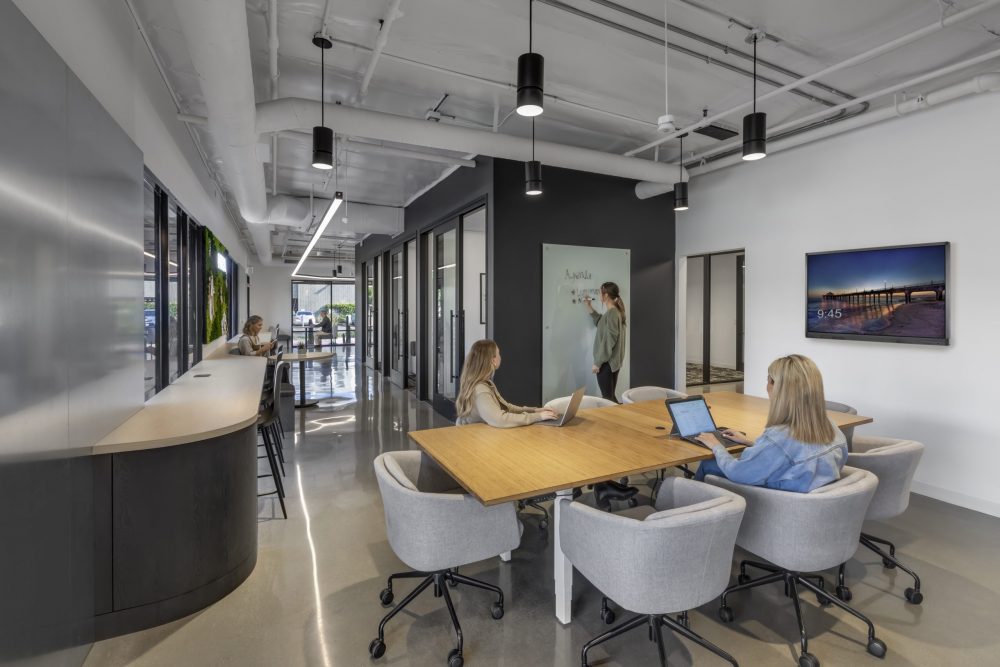Hendy’s Director of Workplace Strategy, Anna Alm-Grayhek, is resurrecting the brick-and-mortar office in 2025 with Gen Z leading the way.
Five years after a global disruption to the workplace, followed by several years of organizations questioning its value and ultimate sustainability, the office is coming back to life – redefining its purpose and proving its resilience as a place where people and businesses can thrive. Here are the driving factors:
Leadership Wants You Back
Amid a flurry of controversy, many organizations have begun mandating that employees return to the office. And debates continue about the reasoning behind it. Some have argued that the hiring boom that happened post-COVID resulted in an excess headcount, and that forcing employees back to the office will result in voluntary departures without the backlash associated with layoffs, or pre-announcements to shareholders. Bottom line, these mandates have been interpreted as “soft layoffs.”
However, many executives will argue that returning to the office has greater value to the organization that goes beyond simply keeping tabs on staff or upping productivity. The idea that having employees physically together in the same location enhances the innovation process, improves communication, and boosts overall organizational engagement has been gaining momentum. And middle managers are feeling the benefits too. The concept of “see and be seen,” means that employees in the office not only have greater exposure to their team, but to leadership as well.
Returning to the office in 2025 will increasingly be driven not by mandates, but by the recognition of the genuine value of being together – connecting, collaborating and building relationships that cannot be replicated in the virtual world.
Employees are Recognizing the Value of In-Real-Life (IRL) Experiences
Gen Z is leading the pack in the trend of returning to the office. Many in this cohort graduated from college during the COVID-19 pandemic, were hired via a Teams interview, and have remained largely in the shadows for the first few years of their career. Working remotely, with limited visibility to management, they have been struggling to move up the ladder. In short, they are ready for a promotion.
Additionally, many employees find that coming to the office is worth the commute. Not just Gen Z’s, but all groups are experiencing that the social bonds formed by being together IRL happen organically and lead to the development of deeper connections and commitment to their team members. And unfortunately, working remotely has isolated many of us. In fact, a recent article in the Harvard Business Review stated that:
Loneliness and isolation have had such a widespread impact on society over the last five years that public health officials have declared the situation an epidemic.
It also states that, “Absenteeism attributed to stress and loneliness costs U.S. employers an estimated $154 billion annually, according to a 2022 article published in the Journal of Organizational Effectiveness: People and Performance. And according to the 2023 U.S. Surgeon General’s “Advisory on the Healing Effects of Social Connection and Community,” workplaces can foster a sense of inclusion and belonging among their employees by creating cultures and practices that encourage people “to connect with one another as whole people, not just as skill sets.”
Improved In-Office Experience
Whether people are looking for a better way to book a seat or schedule time together as a team, advancements in scheduling applications are helping ensure that when employees do come in, they know when and where to find their teammates. The uncertainty around flexible schedules left many employees less-than-excited about showing up at the office. They were often left sitting near the wrong people, or near no one at all. Cisco’s global study revealed that 72% of employees are optimistic about returning to the office if equipped with collaboration-friendly environments. These seamless integrations create a cohesive experience, making in-office collaboration smoother and more efficient than ever.

Furthermore, organizations are finally settling on guidelines and expectations for hybrid working. With the constant tug-of-war employees experienced while companies struggled to “get it right,” the dust has finally begun to settle. Consensus about which job roles should remain in-office, which can be remote, and which can be hybrid, allows offices to be designed in a more intentional way that meets the needs of those who will actually be using them, rather than a one-size-fits-all solution.
The Office as the Physical Manifestation of Brand & Culture
Lastly, the physical office remains the strongest way to celebrate your brand and culture. And a company’s unique brand value proposition is a tool for selling itself to new talent. We remain in an economic landscape with low unemployment, meaning that the demand for talent is still high. Work environments that offer a “vibe” are breeding grounds for creativity and innovation, thereby attracting top tier talent.
The office becomes an opportunity to showcase your values as an organization. It serves as a strategic asset in communicating the brand’s story and vision.
These can range from environmental sustainability, health and wellness, community outreach and many others. Designing an environment that brings these ideas to the forefront can be a major differentiator that sets you apart from the competition.
As we approach the end of 2024, we are ready to leave this rollercoaster of uncertainty. 2025 will be the year that provides clarity, where we can come together and celebrate the value that an office brings to not only the organization, but to the individual as well. After all, humans are social beings who can bring the best versions of themselves to work when they feel connected and engaged in an environment where they can thrive.
Want more insight from Anna? Check out:
It’s Not the Space, It’s the People

